Advancing technology for microscopes calibration
Argolight’s previous calibration slide generation have been released 5 years ago. Luckily, the microscopy community does like to share its thoughts. Since then, Argolight has gathered user feedback. They came from manufacturers, expert microscopists, and core facility managers, worldwide. This prompted the Research and Development team at Argolight to improve the current model of calibration slides.
Here is a sneak peek about one of the most requested improvements, one that Argolight is introducing with the Argolight 2nd generation of products: the doubling of fluorescence intensity.
2nd generation of slides: 100% more intense
Without surprise, the most recurring customers’ comments were “Can you make the fluorescent patterns more visible?”.
Argolight answered with a new generation of calibration slides, using an improved glass technology that produces twice the amount of fluorescence: AG03, the 3rd generation of ArgoGlass®.
Thanks to 3 years of research and development, AG03 has an improved quantum efficiency compared to AG02. It means that a greater share of the incoming light is absorbed and emitted through fluorescence conversion.
Consequently, the patterns now exhibit at least 100 % more fluorescence intensity than the 1st generation for the same exposure, making them more visible across all wavelengths.
The presence of fluorescence inside the slide is still certain and long-lasting. Fluorescence patterns will be visible forever. For that matter, the slides are now warranted for a lifetime.

Left: Intensity responses of the “4×4 intensity gradation” patterns of an Argo-LM v1.0 and an Argo-LM v2.0, imaged with a 20x/0.8 objective, GFP channel, with the same illumination power and exposure time. The ratio between the intensity of the two 16th intensity levels is 4.26.
Right: Comparison parameters between the two intensity responses. The ratio between the slopes of the linear regression curves is 5.48.
This comparison has been made using the “compare intensity response” option in Daybook analysis software.
A line intensity profile was plotted on two images acquired under similar acquisition conditions. The intensity profile of the 1st generation of slide has a scale up to 60 grey values.
The intensity profile of the 2nd generation is up to 150 grey values, so twice the intensity level.
Software used: ImageJ.
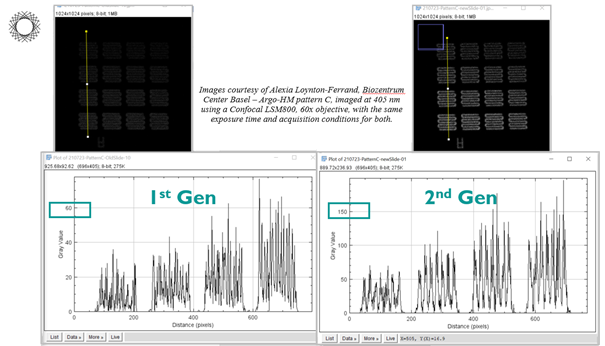
Slides of the 2nd generation have been Beta-tested by a panel of customers, who could compare them against their slide of 1st generation. They all experienced an increased intensity. You can read the full testimonials here.
“I acquired images on a widefield and a confocal and compared intensity and performances against the V1 slide we already had in-house. The slide is indeed brighter. From the histogram during acquisition, I would say it is double.”
Dr. Alexia Loynton-Ferrand, Research Associate in Advanced Light Microscopy, at the Imaging Core Facility, of the Biozentrum Center for Molecular Life Sciences, Basel, Switzerland.
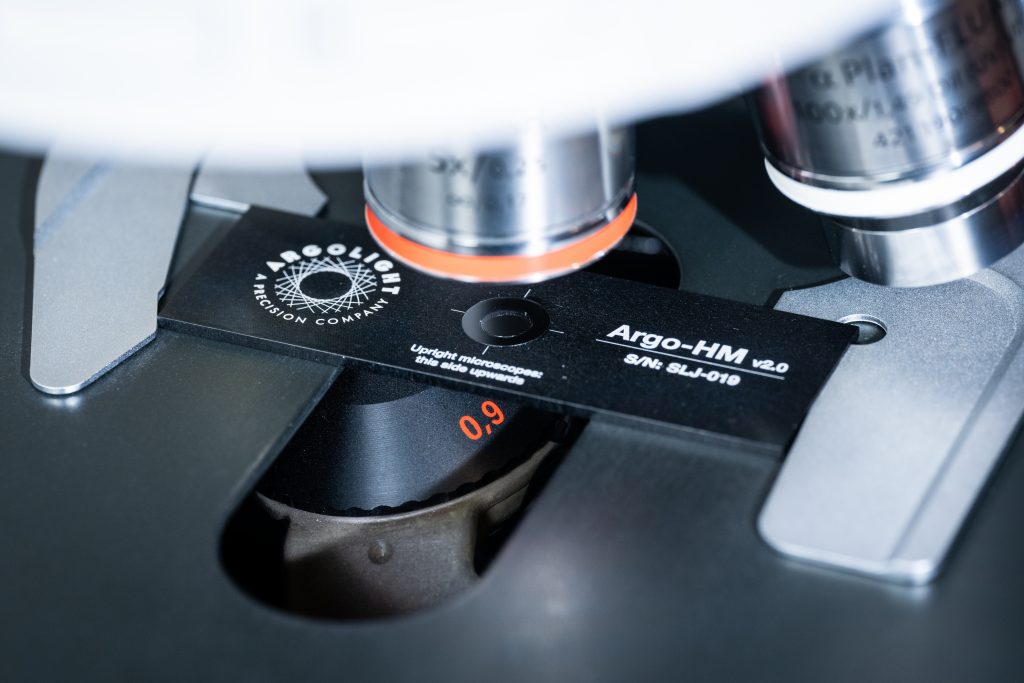
What are the benefits of having more fluorescence intensity?
More fluorescence intensity has often been a request from users whose systems have a weak light source, or overall, who need a very good Signal-to-Noise (SNR) and /or Signal-to-Background (SBR) ratio. After years of research, Argolight has been able to develop fluorescent patterns that emit more fluorescence over all channels, including in the red wavelengths.
Better signal overall, including in the red domain
The intensity is increased on the whole spectrum of excitation. This gives more contrast in images even for in the red wavelengths domain.
“We now can record images with 638 nm excitation which was not possible before.”
Dr. Steffen Dietzel, Head of the Core Facility Bioimaging at the Biomedical Center of the Ludwig-Maximilians-Universität München, in Munich, Germany.
“The new generation is much brighter, in our experience about 2-4 times, compared to the older slides. That significantly improves QC (Quality Control) with low NA/magnification lenses and in the red channels.”
Dr. Martin Spitaler, Light Microscopy Facility Manager at the Imaging Core Facility of the Max Planck Institute of Biochemistry, in Martinsried, Germany.
“This allowed us to utilize the slide closer to usual imaging parameters in terms of excitation and exposure and especially made it more useful for red excitation.”
Dr. Glyn Nelson, Senior staff scientist, Newcastle’s Bioimaging Unit, Campus for Ageing and Vitality, Newcastle, United Kingdom.
More signal
The patterns emit a higher fluorescence signal, and therefore have a greater Signal-to-Noise ratio than the 1st generation, under similar conditions of imaging.
“As the patterns were much brighter compared to the first generation, we could find the patterns faster, reduce exposure times or get less noisy images, which can improve the precision of quantifications.”
Dr. Laurent Gelman and Dr. Laure Plantard, respectively Head of the Facility for Advanced Imaging and Microscopy, and Light Microscopy specialist, Friedrich Miescher Institute, Basel, Switzerland.
Faster acquisition
To get the same amount of intensity than before, the exposition time can now be reduced, provided the illumination power is the same. This is especially useful to optimize the time when acquiring stacks of images.

Lower illumination power required
Because patterns are now more intense, they require less illumination power. This may also reduce the chances of damaging the pattern with strong illumination conditions, which may happen when the slide is used outside of a set protocol.
“An additional bonus of the increased brightness is the reduced laser power. To give you an idea about the laser power required: for the first generation I used to push the laser to 50-60 %, the increased brightness of the second-generation Argo-SIM allowed me to obtain a similar SNR with only 5 % laser power! Reducing the laser power is very important to us at Confocal.nl because reducing the laser power means keeping the cells alive for longer.”
Jeroen Kole, Product Application Specialist, Confocal.nl, Amsterdam, The Netherlands.
More comfortable acquisition
Patterns are more intense and can be found more easily.
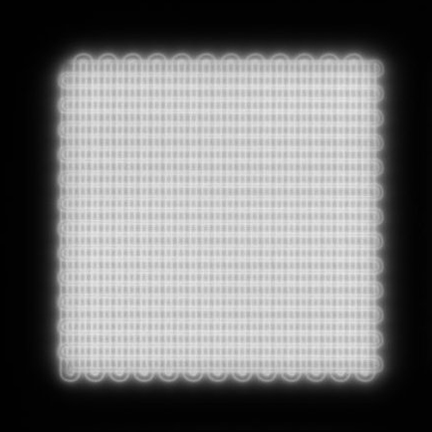
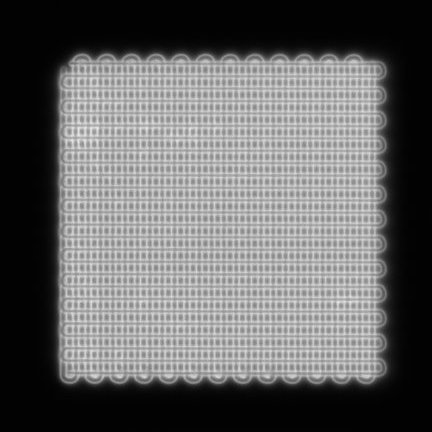
V2 V1
DAPI Channel, under same acquisition conditions
Easier to navigate within patterns
The patterns of the 2nd generation of slides keep the best features of the 1st generation. But some patterns have been improved to ease the exploration of the slide or the image acquisition.
The three standard models – Argo-HM, Argo-SIM, and Argo-LM, display some changes, which can be found in the user guides here. See below what has changed in the most commonly used slide, the Argo-HM.
Target pattern
This is the pattern at the center of the slide. Its size and position make it the reference pattern to ensure the slide is centered in the middle of the field of view.
In the 1st generation, the target pattern consisted of concentric circles with increasing radii from 25 μm to 300 μm with a step of 25 μm, plus an extra circle with a radius of 12.5 μm, featuring a target.
On the 2nd generation, it goes up to 325 µm.
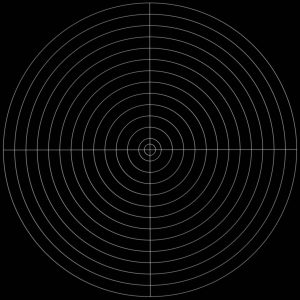
Target pattern – Argo-HM V2
Repositioning crosses patterns
They are located at the edge of the slide, to limit the exploration perimeter in which to find the patterns of interest. They were 20 µm in the 1st generation and now 40 µm in the 2nd generation.
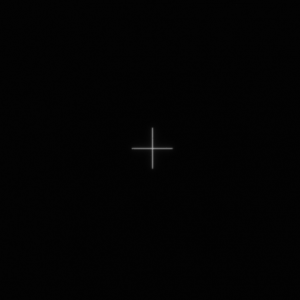
Repositioning crosses pattern – Argo-HM V2
Field of rings (FOR) pattern
It now fits the field of view of a large chip camera for 20x magnification.
In the 1st generation, the FOR pattern consisted of a matrix of 39×39 rings, separated by 15 μm, on a total field of 570 μm × 570 μm. In the 2nd generation, there are 45×45 rings, separated by 15 μm, on a total field of 660 μm × 660 μm.

Field of rings pattern – Argo-HM V2
3D crossing stairs pattern
The Argo-HM and Argo-SIM slides both present the 3D crossing stairs pattern. This pattern consists of twice 11 empty cylinders embedded at different depths, like two crossing stairs going down in Z, surrounded by four pillars.
In the Argo-HM, there are four 3D crossing stairs in the slide, with varying steps: 1 μm, 0.75 μm, 0.5 μm, and 0.25 μm. To make it easier to know the step of the stairs, the step value is now engraved just above the pattern itself.

One of the 3D crossing stairs pattern – Argo-HM V2
Design of the slide
Based on the feedback received from Argolight’s customers on usability, the slide design itself has been improved.
Glass shape
The glass insert is now round-shaped, while it was square on the 1st generation. The round shape makes it easier to clean as oil does not get into the blind holes.
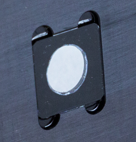
Glass insert – 1st generation
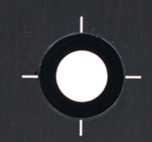
Glass insert – 2nd generation
Instructions for slide positioning
Positioning instructions have been engraved on both sides: it’s now clearer to know which side to put up either on upright or inverted microscopes. It reduces mistakes – straight to the point, even at first use.
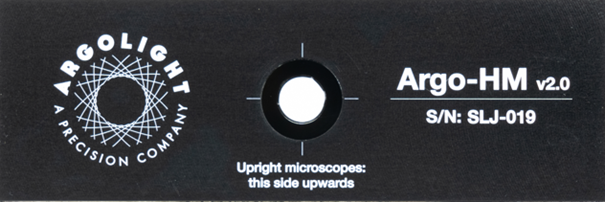
Argo-HM V2 – recto
Slide model
The slide model is now written on the slide itself: easier to pick the desired slide for multiple-slides owners.

Argo-HM V2 – recto
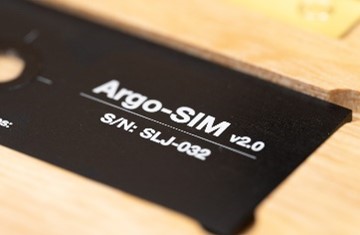
User- and environment-friendly packaging
To reduce the impact on the environment, the packaging of the slides has been renewed. It is now fully recyclable: made of cardboard instead of polymer foam.
The holder itself, previously an X-shaped aluminum one, has been replaced by a box made of locally sourced wood. The new older is more conventional than the previous one and easier to handle. The closing is secured by a magnet.
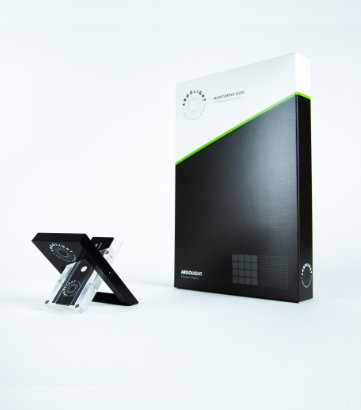
1st generation of slides with X-shaped holder

2nd generation of slides with wooden box
More comfort of use, from small handling details to a great intensity improvement: the second generation of Argolight slides has been thought with users and designed for users.
If you wish to share your feedback too or suggest improvements, you can write at customer@argolight.com.
Related terms: fluorescence intensity, calibration sample, fluorescent pattern, grid, fluorescent target, confocal monitoring
Header photo by Argolight
User case: Kyoto University x Argolight – Fluorescent proteins observation
Matsuda Lab, Graduate School of Biostudies/Graduate School of Medicine, Kyoto University Introducing Argolight slides - A New Quality Control...
Quality control of HCS-HTS fluorescence imaging systems
In the landscape of high-content screening (HCS) and high-throughput screening (HTS) fluorescence imaging systems, precision and reliability take...
Precision Partners: Innopsys and Argolight on the InnoQuant Slide Scanners
In the intricate realm of pathology, drug discovery, and advanced research in brain function, cancer, and stem cells, the role of slide scanners has...


